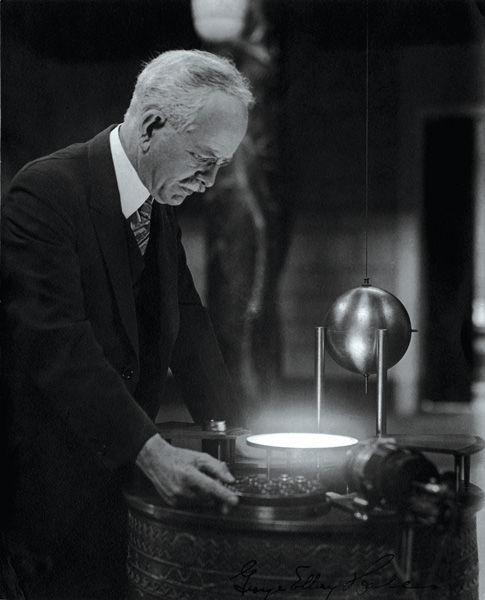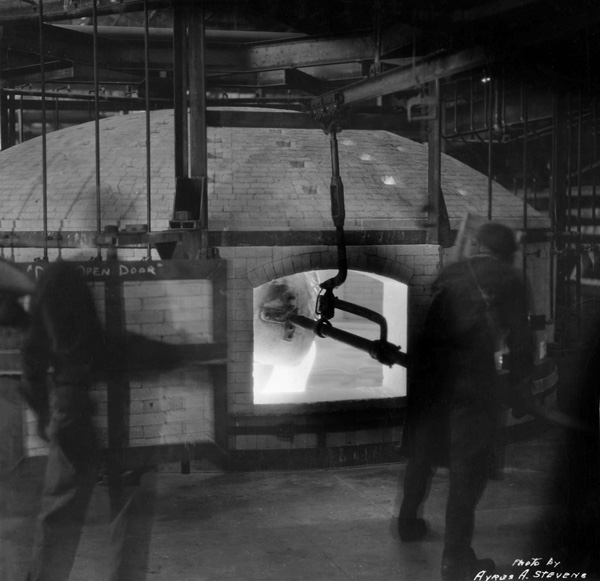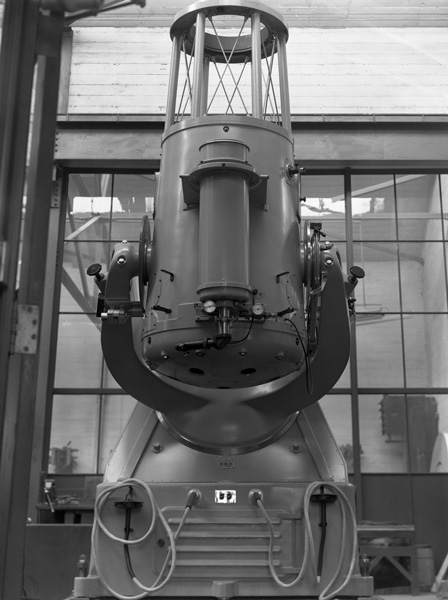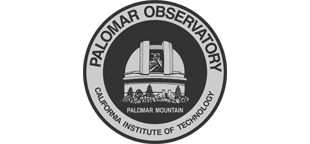
|
|

|
A History of Palomar Observatory
Palomar Observatory is among the most iconic scientific facilities in the world, and a crown jewel in the research traditions of Caltech. Conceived of nearly 100 years ago, the observatory has been in continuous scientific operation since the mid-30s, and remains productive and relevant today. Palomar is most directly the vision of George Ellery Hale (1868–1938). In a tour-de-force effort framed by the challenges of the Great Depression and the Second World War, Hale and a dedicated group of astronomers, engineers, technicians, and builders secured funding, designed the telescopes and site, and created the Observatory in much the same state as it exists today.
George Ellery Hale was the person most responsible for the building of Palomar Observatory. A graduate of MIT and a founder of Caltech, in 1928 he secured a grant of $6 million from the Rockefeller Foundation for the fabrication of a 200-inch reflecting telescope.[1] During the 1930s, he assembled a remarkable team of engineers and designers from academia and industry. Under his direction, these people set to work on the mirror, on the mounting, and on the dome and its support facilities on Palomar Mountain. A triumph of innovation, insight, persistence, and precision the telescope was dedicated in June 1948 ten years after Hale's death.[2] This is the Hale Telescope at Palomar Observatory, an instrument that after many decades of service continues to play a leading role in the advancement of astronomy and astrophysics.
- Beginnings
- The mirror to 1936
- Site selection and building the dome
- The telescope mounting and final work on the dome
- Other telescopes at Palomar
- Completion of the Hale Telescope, 1936 to 1949
- The science programs
- Surveying the sky
- Calibrating cosmic distances
- Measuring the expansion
- Defining stellar populations
- Characterizing quasars
- Pioneering infrared astronomy
- Tracking near-Earth asteroids
- Modernizing Palomar
- The search for comets and asteroids
- Discovering trans-Neptunian objects
- Mapping the transient sky
- Media
- Notes
Contents
Beginnings
Hale had experience building large telescopes. In fact, he was responsible for building the largest telescope in the world four times: the 40-inch refractor at Yerkes in 1897; the 60-reflector on Mt. Wilson in 1908; and the 100-inch Hooker reflector on Mt. Wilson in 1917.[3]
The Rockefeller Foundation grant. Duration: 1:58 min. (Palomar/Caltech)
In requesting funds from the Rockefeller Foundation, Hale turned to the popular media where he presented general arguments for the public and more specific arguments for the specialists among his readers. On one hand, he compared the proposed work to the European voyages of discover. The early explores discovered things they did not expect to find. And with this point, he argued that whenever we construct larger telescopes we always discover things we had not expected. In an article in Harpers Magazine for April 1928, he wrote passionately about "the lure of the uncharted seas of space."[4] On the other hand, however, he also had a specific scientific agenda for his proposed telescope. He was concerned with the evolution of stars and the constitution of matter. But in particular, he wished to extend the recent discoveries made by Edwin Hubble and others concerning the large-scale structure of the universe.
At the same time, George Hale wanted to build a telescope that would expand the capabilities of the Hooker Telescope while also making up for its defects. Working on Mt. Wilson, Hubble complained bitterly to Hale about among other things the quality of the Hooker's 100-inch mirror and the telescope's inability to observe the northern reaches of the sky. Hale wanted a new, larger telescope of such impeccable quality and precision that its performance on the sky would quiet the demands of Edwin Hubble.
And from his earlier experiences with large telescopes, Hale knew that the fabrication of the mirror would pace all the other tasks in the construction project.[5]
The Mirror to 1936
In fact, in the 1928 article Hale referred to the question of the successful completion of the mirror disk as "the only uncertainty" in the massive building project he was proposing.[6]
Building Palomar Observatory. Duration: 4:18 min. (Palomar/Caltech)
Perhaps he had reason for concern. The mirror in the Hooker Telescope had never performed well. Cast in layers, it was made of plate glass and the accuracy of parabolic reflecting surface suffered considerably whenever Mt. Wilson was subject to a change in temperature. He wanted to use fused quartz for the mirror of the new telescope because this material was known to be least subject to such temperature-induced shape changes. "The first step," he argued, "should be to determine by experiment how large a mirror disk, preferably of fused quartz, could successfully be cast and annealed.".[7]
A resolution of this issue was not long in coming. Hale and the Board of Trustees had given the work of fabricating a fused quartz disk to Elihu Thomson at General Electric Corporation in West Lynn, Massachusetts. By March 1931, Thomson had spent $600,000, one tenth of the entire budget of the project, and, after many months of work, had failed to produce a 60-inch fused quartz test mirror. Hale quickly put an end to this experiment and to the project's relations with GE.[8] Rather than continue in that direction, he turned to Corning Glass Works in Corning, New York and a relatively new product that Corning had begun to produce called Pyrex.[9]
Pyrex is only slightly less thermally stable than is fused quartz. Hale hoped that the fabrication process at Corning would be far less complex than was the spraying and layering process that GE had developed for its product.
Nonetheless the work at Corning was not without its difficulties. George McCauley was in charge of the work.[10] He experimented with different formulations of the glass and with different designs for the annealing oven. He developed procedures for pouring the molten glass. In March 1933 he successfully produced a 120-inch test disk that was intented to be polished as an optical flat for testing purposes. With this test disk in hand, work went ahead on preparations for pouring the 200-inch mirror blank.[11]
The mold was constructed and vats were created to hold the liquid glass. A system of overhead tracks with rollers was created from which ladles were suspended so that workers could transport the hot glass from the vats to the oven. By March 1934 preparations were complete. A project of great popular interest, the public was permitted into the factory to witness the event; newspaper and radio reporters were present to report to the nation.[12]
But soon after the pouring began, disaster struck. Firebricks had been secured to the bottom of the oven to create voids in the back of the mirror. Subject to the intense heat of the molten glass, the steel bolts that held the bricks in place melted allowing them to float to the surface thereby ruining the disk.
This failed mirror blank is now on display at the Corning Museum of Glass in Corning, New York.[13]
With the issues with the firebrick resolved, on Sunday, December 2, 1934 a second pouring was made. The work was done on Sunday when most of the public was at home. No announcements were made and no reporters were allowed. As the last ladle of hot glass went into the oven, McCauley judged it likely that a successful pouring had been achieved.[14] He sealed the oven to allow a 10-month long annealing process to begin.
In fact, these were 10 eventful months. Of a number major and minor events, the most serious occurred in July 1935 when, in the midst of a protracted downpour that affected the entire region, the Chemung River overflowed the dykes along its banks and threatened to destroy the electronic controllers that maintained the temperature in the annealing oven. Only the heroic efforts of Corning employees, city firemen and others saved the mirror from a catastrophic drop in temperature.[15]
Mirror transit slideshow: 35 images and 2 videos. Click ► to start. Use < or > to reverse or advance one slide, or the progress dots to jump slides. Click any image to enlarge and on some captions for further context. The slideshow will pause for videos.
Even so, during the high water the electricity failed and for three days the mirror blank cooled uncontrollably. George McCauley became seriously concerned. But there was nothing to be done until the cooling process was complete. On October 25, 1935, he opened the oven.[16] Though scarred and with several surface blemishes, the mirror blank was judged to be in sufficiently good condition that, with the approval of the committee overseeing the construction, it could be sent to Caltech for grinding and figuring and for eventual installation in the telescope.
Therefore, in March 1936, the disk was loaded on to a specially constructed railroad car and on March 26 it began its journey across county to the optical shop at Caltech in Pasadena.[17] As the train moved across the country, people came out to the tracks to see the “Big Eye” pass by. On April 10, 1936 the freight car carrying this special cargo arrived at the rail yard in East Pasadena. The disk was then moved by truck to Caltech were it was expected that the task of grinding and figuring—taking 4.5 tons of glass off its surface to create the correct parabolic shape—would be accomplished in six or seven years.[18]
As it turned out, the process of figuring the mirror would not be completed until 1949.
Site Selection and Building the Dome
In proposing to build a 200-inch telescope, George Hale had sought to mitigate one of the problems that increasingly plagued the telescopes on Mt. Wilson. The performance of the 100-inch telescope was being degraded by the bright skies of Los Angeles.[19]
By contrast, in the 1930s the area around Palomar Mountain was one of the darkest regions in the nation. There were many reasons for the selection of Palomar Mountain as the site for the 200-inch telescope. Its dark skies was probably key among them.
Hale dome construction slideshow: 37 images and 1 video. Click ► to start. Use < or > to reverse or advance one slide, or the progress dots to jump slides. Click any image to enlarge and on some captions for further context. The slideshow will pause for videos.
At the same time, the job of collecting data on the seeing qualities of a number of possible sites in the southwestern US had been going forward. In March 1934 Hale came to Palomar Mountain and, having been assured that the mountain was geologically stable, became enamored of the location. On September 21, 1934, Caltech purchased 120 acres of land on Palomar Mountain for $12,000 from the Beach family.[20] As part of the agreement, the County of San Diego pledged to build a road to the site, a road now designated as county road S6, at the time known popularly as the "Highway to the Stars.".[21]
With title to the site secured, work then began on the support facilities and on the dome itself. Because a great deal of concrete would need to be poured, wells were dug and a water tower was the first structure on the property. Because the electric grid did not then exist and there were no power lines near the mountain, a station was built and generators were installed to supply the site with electricity.[22]
Workers were hired, some with welding and other skills, some as laborers. A tent village was setup to house them and soon work began on the foundations of the dome. By the winter of 1936-37, the 30-foot high base of the observatory was complete, the rails that the dome would ride upon were in place, most of the upper surface of the dome had been installed and the workers were ready pour the concrete floor of the observatory. Byron Hill was in charge of construction and by the middle of 1937 the structure was enclosed.[23] With that done, the dome was ready to receive the telescope and its mounting.
The Telescope Mounting and Final Work on the 200-inch Dome
For the telescope itself, George Ellery Hale turned to an engineer named Clyde McDowell. In turn, McDowell sought out Westinghouse Corporation with facilities in South Philadelphia to fabricate the massive but very precise elements of the telescope and its mounting.[24]
The story of the design of the telescope is perhaps one of the most remarkable parts of the larger story of the creation of Palomar Observatory. If Hale may be considered a genius, one element of his genius lay in his ability to draw in men like McDowell and build teams that could solve problems, compromise and innovate while never sacrificing the integrity of the final product.
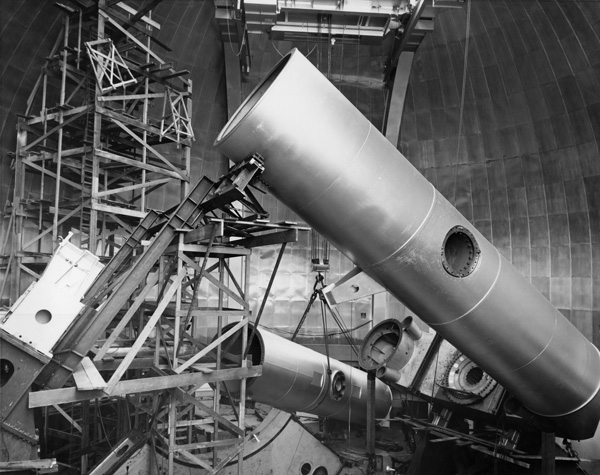
Building of the Hale Telescope mount, circa January 1939. Photograph by Lee A. Farnsworth, Jr. (Farnsworth Family Estate)
An important factor in maintaining that integrity may well be found in still another individual that Hale brought into the project. A man deemed eccentric by the engineers around him, Russell Porter had been an artic explorer, an illustrator, a machinist, an amateur astronomer and builder of amateur telescopes.[25] Above all else, he seems to have had a passion for simple design, something he combined with a unique ability to render complex machines in elegant charcoal drawing. While he designed the dome itself, Porter may be best known for the stylized images he produced from the raw architectural drawings. He made images of the finished telescope before it was finished. He did "cutaway" drawings that showed how all the elements worked in unison. He gave context to the many disparate segments of the project that brought the work of distinct groups together into a cohesive whole.
In this way, innovations in the design could be introduced and compromises could be accepted: a truss system was adopted for the tube that would keep the optics aligned as the telescope slewed across the sky; oil bearings were designed to allow the 530-ton telescope to move in right ascension with precision; a "phantom" telescope was created to keep the opening in the dome above the telescope as the telescope tracked objects across the sky.[26] These and a series of other elements all came together.
Supported by a yoke mounting with a horseshoe bearing on the north end, Westinghouse completed the truss tube and held a dedication ceremony in South Philadelphia on April 30, 1937.[27] Albert Einstein attended this event, his only known association with the 200-inch telescope.
Soon there after, parts of the tube and the mounting, having been shipped through the Panama Canal to the Port of San Diego, began arriving on the mountain. And on April 11, 1939 the dome and the telescope—without its mirror—were complete. While the installation and testing of the tracking and other control systems would continue, the Observatory could now await the completion of that mirror. According to the press release that announced the completion of the telescope, the mirror was expected to arrive on the mountain no later than December 1940.[28]
Other Telescopes at Palomar
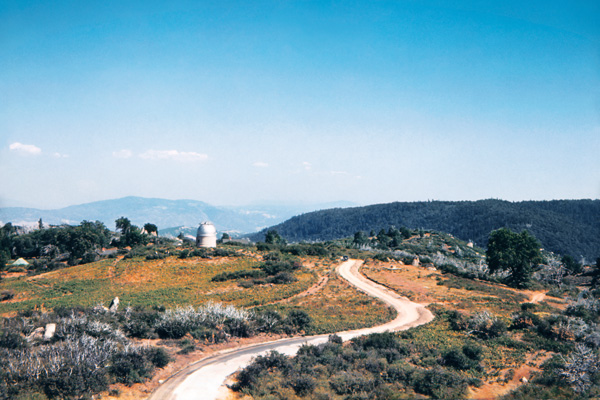
18-inch Schmidt dome from the external catwalk of the 200-inch telescope dome, August 1939. Photograph by Edwin F. Carpenter. (Palomar/Carpenter Collection)
George Hale is identified as the man most dedicated to the creation of ever-larger telescopes. True as that may be, he and the astronomers he worked with on the Palomar project also recognized the utility of smaller telescopes that could be used for surveys.
Indeed, a big telescope tends to capture only a tiny portion of the sky on each photograph. A number of the scientists who worked with Hale advocated the building of a newly developed type of telescope that could image large portions of the sky on a single plate. A Schmidt telescope—named for its designer, Bernhard Schmidt—would be capable of locating objects of interest and to one astronomer, Fritz Zwicky, supernova were objects of intense interest that could only be found using a wide-field survey instrument. At the prompting of Zwicky and Walter Baade, Hale approved funds for the construction of such a telescope even before the 200-inch mirror blank arrived in Pasadena.[29]
With breath-taking speed, a dome was erected on the mountain to the east of the site selected for the 200-inch telescope and an 18-inch Schmidt telescope was fabricated at Caltech. By the fall of 1936, the telescope had been installed and was in operation. Destined for a long record of service at the Observatory, this instrument was used by Zwicky to discover a great many of supernovae. [30]
Not without good reason, Zwicky's success gave rise to interest in developing a larger Schmidt telescope, one that would reach much fainter objects and could supply the 200-inch telescope with an unending list of important things to examine. Having been forced to guess at the most promising locations for finding faint galaxies when using the 100-inch telescope, Edwin Hubble entered this discussion and, under pressure from many sides, Hale requested permission to use funds from the grant for such an instrument. The General Education Board of the Rockefeller Foundation gave its approval in May 1937 and construction on the 48-inch Schmidt telescope began almost immediately.[31]
Completion of the Hale Telescope, 1936 to 1949
The mirror blank had arrived at Caltech in April 1936. Hale knew that the fabrication of the mirror would be the item that paced the entire project. He had hoped that the grinding, polishing and figuring of the mirror would be complete in six or seven years and to those involved in the project there must have been times when Hale’s estimate seemed a distant dream.
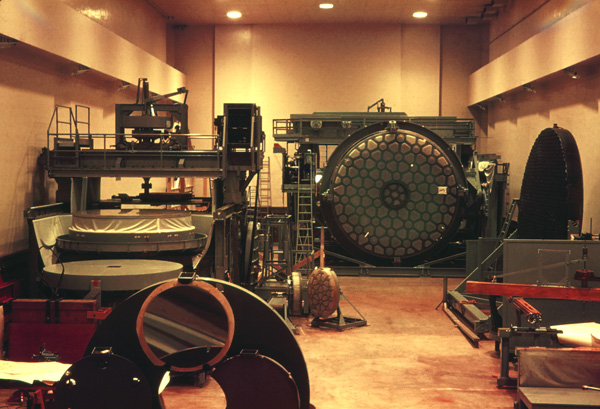
The 200-inch disk in the Caltech optical shop, August 1939. Photograph by Edwin F. Carpenter. (Palomar/Carpenter Collection)
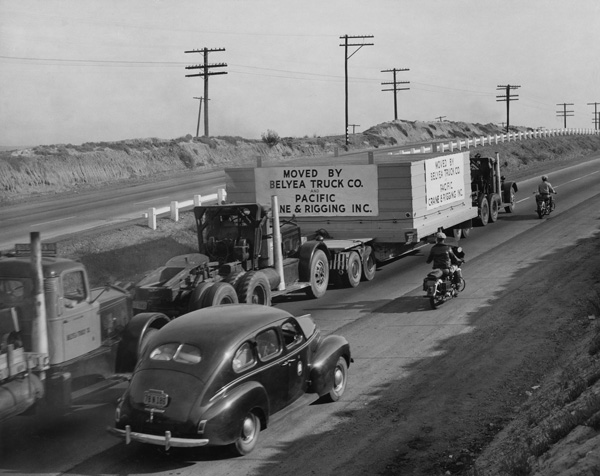
Transport of the 200-inch disk from Pasadena to Palomar Mountain, November 1947. Photograph by Dick Whittington. (Palomar/Belyea Collection)
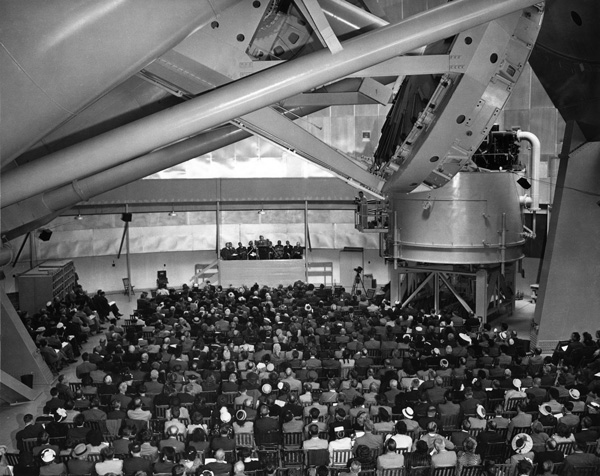
Caltech president Lee A. DuBridge formally dedicates Palomar Observatory and names the 200-inch the Hale Telescope on June 3, 1948. Nearly 1,000 invited guests attended the ceremony. Other speakers included Raymond B. Fosdick, President of the Rockefeller Foundation; Max Mason, Chairman of the Observatory Council; Vannevar Bush, President of the Carnegie Institution of Washington; Ira S. Bowen, Director of Mt. Wilson and Palomar Observatories; and James R. Page, Chairman of the Caltech Board of Trustees. Also on the speakers' stand are Walter S. Adams, Director Emeritus of the Mount Wilson Observatory and member of the Palomar Observatory Council, and Mrs. Evelina Hale. (Palomar/Caltech)
Indeed, a great deal of work had to be done. In the end, four and one half tons of glass had to be removed first to create a spherical surface and then in the figuring process tiny amounts had to be taken off to achieve a final surface accurate to within 2/1,000,000ths of an inch of a perfect paraboloid.[32]
The process, however, may well have seemed endless. Plagued by doubts concerning the quality of the glass, after a year in the optical shop, Marcus Brown, the chief optician, and his crew had barely finished preparing the surface and had used up five tons of carborundum in the process. But grinding the concave curve began immediately and, oddly enough, by the summer of 1941, the mirror was nearing completion. In August, Brown began the work of creating the parabolic figure—the last stage in the work—and by the end of September he estimated the “parabolization” of the mirror was 90 percent complete.[33]
But increasingly workers were being taken off his crew and put on jobs for the military. Work slowed and by late spring 1942 the mirror project was on hold.
Even so, the telescope project never stopped entirely. In mid-1945, Ira Bowen was appointed director of the jointly operated Mt. Wilson and Palomar Observatories. Soon thereafter he was meeting in Pasadena with Hubble, Baade, and others to make plans for the allocation of research time on the 200-inch telescope.[34] And on December 17, 1945 Marcus Brown gathered up a largely new crew of workers and restarted the motors on the polishing machine.[35]
A tedious and exacting task, nonetheless in just over a year the mirror was nearing completion. Early in 1947, John Anderson, an optician, a physicist, and executive director of the Observatory Council, declared that the surface was within the engineering tolerances required of a true paraboloid. After several additional months of testing and fine figuring, in October 1947 Anderson declared the mirror finished.[36] It was then packed and crated and placed on a flatbed owned by Belyea Truck Company for shipment to Palomar. On November 18, 1947 the finished mirror left Caltech and journeyed down highway U.S. 101 to Oceanside. After a night’s layover in Escondido, on a rainy and cold day, it was brought up the “Highway to the Stars”, now the S6, and into the Observatory.[37] After applying a thin coating of aluminum, the mirror was installed in the telescope during Christmas 1947.[38]
At this point it was discovered that John Anderson’s optimism had been premature. In fact, the edges of the mirror did not sag as predicted and work on the mirror would need to continue for a year and a half. In addition, a series of adjustments were made to remove a slight astigmatism and correct other issues with tracking system. Even so, as these matters were being attended to, the Dedication took place on June 3, 1948 with speakers from Caltech and the Carnegie Institution and nearly 1000 invited guests seated under the telescope on the observing floor.[39]
Finally, on January 26, 1949 Edwin Hubble exposed the first image. For the occasion he selected NGC 2261, an object he had identified as being variable in brightness and one that carried the name Hubble’s Variable Nebula. His image represented “First Light” on the Hale Telescope.[40] After one more round of tuning the mirror supports, a new coating of aluminum was placed on the surface in October 1949.[41] Regular observing programs began with the Hale Telescope soon thereafter. Science programs had begun and the telescope now belonged to the astronomers and the astrophysicists.
The Science Programs
Of course, science programs at Palomar had been going on since 1936 with Fritz Zwicky’s searches for supernovae using the 18-inch Schmidt.[42] In addition, science programs using the 48-inch Schmidt telescope—later the Samuel Oschin Schmidt Telescope—began a year before the Hale Telescope went into service. An image of the Andromeda Galaxy, M31, the first official photograph was taken with the 48- inch Schmidt Telescope on September 24, 1948.[43] Ten months later on July 19, 1949, the first plates were made for a sky survey jointly sponsored by Palomar Observatory and the National Geographic Society. Taking a number of years to complete, copies of the plates of the first National Geographic Society – Palomar Observatory Sky Survey (POSS I) became standard reference materials for astronomers around the world.[44]
And so a basic relationship was established that, with some changes in emphasis and with many changes in technology, continues to today: night after night the 48-inch telescope photographs large sections of the sky and the 200-inch telescope examines in detail the most interesting objects found in those photographs. After 1970, the 60-inch telescope was added to take a portion of the observing load off of the Hale Telescope.[45]
Since Zwicky’s observations in the 1930s, the Observatory has continued to work upon the three science investigations that George Ellery Hale originally laid out in his 1928 Harpers article: the structure of the universe, the evolution of stars, and the constitution of matter.[46]
In the period since 1949, from among a long list individual contributors, the following astronomers may well be recognized as carrying out important roles in moving forward Hale’s agenda for the 200-inch telescope:
Surveying the Sky
Mapping the sky with the Palomar telescopes. Duration: 6:20 min. (Palomar/Caltech)
Framed by scientific collaboration with Walter Baade, Fritz Zwicky grasped the important, complementary role that broad reconnaissance should play to the detailed studies enabled by the Hale Telescope, and saw the potential of the newly-invented Schmidt telescope in realizing that reconnaissance. His intuition proved to be correct—within a year of the 18-inch Schmidt becoming operational, Zwicky began his long and unprecedented success at recording supernovae explosions. By 1973, he had discovered over 120 supernovae with the Palomar Schmidts and held the record for the greatest number of supernova discoveries achieved by any individual until 2009. Zwicky's second major observational program at Palomar was the study of galaxy clustering, made possible by the surveying capability of the Schmidts. This study culminated with the publication of the six-volume Catalogue of Galaxies and of Clusters of Galaxies between 1961 and 1968. [47]
Calibrating Cosmic Distances
Measuring cosmic distances. Duration: 3:33 min. (Palomar/Caltech)
Working at Palomar and at Mt. Wilson, Baade discovered the existence of two populations of Cepheid variables. Objects of intrinsic brightness, his observations of these populations allowed him to recalculate the distance scale previously established by Edwin Hubble and, in so doing, also to double our understanding of the size of the known universe. He announced his findings in 1952 at a meeting of the International Astronomical Union.[49]
Measuring the Expansion
A protégé of Edwin Hubble, Allan Sandage has been considered the preeminent observational cosmologist of the later part of the 20th century. He built upon the work of Edwin Hubble and Baade. In a paper published in 1958, he again increased the size of our perceived universe and brought the value of the Hubble Constant to 75km/s/Mpc, close to its modern value.
As part of this work, while using the Hale Telescope, Sandage described and measured the linearity and isotropy of expansion of the universe. The universe was, he declared, essentially similar in all directions, an assertion that is at the foundation of modern cosmology.[50]
Defining Stellar Populations
Cosmic chemistry. Duration: 2:38 min. (Palomar/Caltech)
In a search of distinct stellar populations, Jesse Greenstein working with Rudolph Minkowski and others used spectroscopic techniques on the Hale Telescope to assess the composition of stars. Among the populations he investigated, he found great variations in the concentrations of nitrogen, oxygen and other elements. With this data, Greenstein shared his research with William Fowler who went on to describe how stars synthesize heavier elements from lighter ones.[51]
Characterizing Quasars
The hearts of galaxies. Duration: 3:33 min. (Palomar/Caltech)
In 1963, Maarten Schmidt examined the optical counterpart of the radio source 3C 273. Termed a “quasar”, its red shift—(0.157)—indicated that this object must reside a great distance and with this distance measurement it could be shown that it also must be producing energy at a prodigious rate with a luminosity 4 trillion times that of the Sun.
Schmidt’s discoveries prepared the way for theories of black holes at the center of galaxies. Through accretion of material from the disks of their host galaxies, black holes have come to be seen as the engines of the new class of objects known as Active Galactic Nuclei (AGN).[52]
Pioneering Infrared Astronomy
Director of Palomar Observatory from 1980 to 1994, Gerry Neugebauer was a pioneer in the field of infrared astronomy. Working with Eric Becklin, he identified thousands of infrared sources and, using both satellite and ground based instruments, made the first observations of the center of our galaxy. Neugebauer played an important role in the design and construction of the W. M. Keck Observatory in Hawaiʻi.[53]
Tracking Near-Earth Asteroids
Using the 18-inch telescope, Eleanor Helin is credited with discovering or co-discovering 516 asteroids in addition to several comets.[54] She initiated the Palomar Planet-Crossing Asteroid Survey in the early 1970s. An advocate of bringing automated methods to the work of conducting astronomical surveys, she later became the principle investigator for NASA’s Near-Earth Asteroid Tracking program. During eleven years of its operation, this program found more than 36,000 solar system objects 442 of which have been classed as near-Earth objects.
Eleanor Helin was among the first women permitted to use the facilities of Palomar Observatory.[55]
Modernizing Palomar
Working with James Westphal and other collaborators, James Gunn is often cited as the person most responsible for the modernization of Palomar Observatory. Moving away from the era of the photographic plate, he developed the first electronic camera used on the Hale Telescope, a CCD based device he named Four-Shooter. He contributed to the design of the cameras used on the Hubble Space Telescope.
A theorist as well as a gadgeteer, Gunn studied the formation of galaxies and put forward ideas concerning the relationship of the inter-galactic medium to galactic evolution.[56]
The Search for Comets and Asteroids
The new Solar System. Duration: 3:32 min. (Palomar/Caltech)
Carolyn Shoemaker was an astronomer who beginning in 1980 used the 18-inch telescope to search of Earth-crossing asteroids. Gene Shoemaker was a geologist and an early advocate for the science of astrogeology. Together with David Levy, they are credited with using the 18-inch telescope to discover Comet Shoemaker-Levy 9 on March 24, 1993. Over a year later in July 1994, this comet broke apart before colliding with Jupiter.[57]
Discovering Trans-Neptunian Objects
A Caltech astronomer, Mike Brown used the 48-inch Samuel Oschin Schmidt telescope to discover an object beyond the orbit of Neptune that would eventually be named Eris. It was this discovery on January 8, 2005 and question of whether or not this object ought to classed as a planet that led directly to a protracted controversy over the status of the planet Pluto. This debate resulted in the creation of the new category of “dwarf planet” and the demotion of Pluto. Mike Brown styles himself as the man “who killed Pluto.”[58]
Mapping the Transient Sky
A program with a very long list of contributors, The Palomar Transient Factory was an automated survey system searching for optical transient and variable sources. The program began operations on the Samuel Oschin Schmidt Telescope on December 13, 2008 and completed commissioning during the summer of 2009. Between that time and late summer 2014, PTF and its successor have found 2,288 supernovae.
The system used a number of partner institutions to conduct automated image subtraction and image classification. All of the resources of Palomar Observatory were brought to bear in this program: the 48-inch telescope to capture images of the entire visible sky every five days; after image subtraction and classification, transient objects of interest were subject to photometric measurements on the 60-inch telescope. Those things that continue to demand attention were then examined spectroscopically with the Hale Telescope or other large instrument.
An upgraded version, the Intermediate Palomar Transient Factory, replaced the original PTF. In 2017 a more advanced upgrade, the Zwicky Transient Facility, replaced iPTF. The original concept continues: with greatly improved detectors, 48-inch telescope continues as a survey instrument supplying scientifically valuable targets to the larger telescopes on the mountain and elsewhere.[59]
Media
A collection of images and videos pertaining to the Observatory's history can be found in the vintage media gallery. Chronology presents a graphic timeline of Palomar-related events since the 1920s to the present. Iconic images from the science programs are distributed throughout the telescopes pages as well as in the astronomical media gallery.
Notes [show]
- Ronald Florence, The Perfect Machine: Building the Palomar Telescope (New York: HarperCollins Publishers, 1994), 70-92. Hereafter as Florence, Perfect Machine.
- Florence, Perfect Machine, 392–394.
- Florence, Perfect Machine, 31–40, 37–39, 45–46.
- George Ellery Hale, “The Possibilities of Large Telescopes,” Harpers Magazine (New York: Harper and Brothers, Publishers), April 1928, 239. Hereafter as Hale, Harpers.
- Hale, Harpers, 646.
- Hale, Harpers, 646.
- Hale, Harpers, 646.
- Florence, Perfect Machine, 157–164.
- Florence, Perfect Machine, 167–169.
- Florence, Perfect Machine, 165–184.
- Florence, Perfect Machine, 190–195. The 120-inch disk was eventually given a parabaloid figure and installed in the Shane Reflector at Lick Observatory.
- Florence, Perfect Machine, 196–205.
- “One of the most interesting aspects of glass is how it reacts with light,” retrieved July 25, 2014 from http://www.cmog.org/collection/glass-innovation-center/optics-gallery.
- Florence, Perfect Machine, 223–226, 232–241.
- Florence, Perfect Machine, 234–237.
- Florence, Perfect Machine, 240–242.
- Florence, Perfect Machine, 249–250.
- Florence, Perfect Machine, 252–254.
- Florence, Perfect Machine, 106–107.
- Florence, Perfect Machine, 211.
- Florence, Perfect Machine, 230.
- Florence, Perfect Machine, 316.
- Florence, Perfect Machine, 225–260, 293–295.
- Florence, Perfect Machine, 281–288.
- Florence, Perfect Machine, 93–94.
- Florence, Perfect Machine, 289–293, 216–217, 321.
- Florence, Perfect Machine, 290–291.
- From a notation on the back of a press image in the collection at Palomar Observatory; see also, Florence, Perfect Machine, 334, 341–342.
- Florence, Perfect Machine, 257–261.
- Florence, Perfect Machine, 261.
- Florence, Perfect Machine, 281–282.
- Florence, Perfect Machine, 369.
- Florence, Perfect Machine, 344.
- Florence, Perfect Machine, 362.
- Florence, Perfect Machine, 365.
- Florence, Perfect Machine, 367.
- Florence, Perfect Machine, 373–379.
- Florence, Perfect Machine, 386.
- Florence, Perfect Machine, 392–393.
- Florence, Perfect Machine, 395.
- Florence, Perfect Machine, 398.
- Florence, Perfect Machine, 260.
- Florence, Perfect Machine, 397.
- Florence, Perfect Machine, 397; see also, “The National Geographic – Palomar Observatory Sky Survey (POSS I) is a major photographic survey of the night sky that was completed at Palomar Observatory in 1958,” retrieved August 6, 2014 from http://en.wikipedia.org/wiki/National_Geographic_Society_-_Palomar_Observatory_Sky_Survey.
- “The Palomar 60-inch telescope, located in the Oscar G. Mayer Memorial Building, was built to take some of the demand off the 200-inch Hale Telescope,” retrieved August 19, 2014 from http://www.astro.caltech.edu/palomar/about/telescopes/60-inch.html.
- Hale, Harpers, 641.
- Florence, Perfect Machine, 259–261, 405–406; see also “Fritz Zwicky (February 14, 1898 – February 8, 1974) was a Swiss astronomer,” retrieved July 30, 2014 from http://en.wikipedia.org/wiki/Fritz_Zwicky.
- Florence, Perfect Machine, 406; see also “Edwin Powell Hubble (November 20, 1889 – September 28, 1953) was an American astronomer who played a crucial role in establishing the field of extragalactic astronomy and is generally regarded as one of the most important observational cosmologists of the 20th century,” retrieved August 12, 2014 from http://en.wikipedia.org/wiki/Edwin_Hubble.
- Florence, Perfect Machine, 352–355, 403–404; see also “Wilhelm Heinrich Baade (March 24, 1893 – June 25, 1960) was a German astronomer who worked in the USA from 1931 to 1959,” retrieved August 12, 2014 from http://en.wikipedia.org/wiki/Walter_Baade.
- Florence, Perfect Machine, 404–406; see also “Allan Rex Sandage (June 18, 1926 – November 13, 2010) was an American astronomer,” retrieved August 12, 2014 from http://en.wikipedia.org/wiki/Allan_Sandage.
- “Jesse Leonard Greenstein (October 15, 1909 – October 21, 2002) was an American astronomer,” retrieved August 15, 2014 from http://en.wikipedia.org/wiki/Jesse_L._Greenstein; see also, “Interview in three sessions in 1982 with Jesse L. Greenstein, DuBridge Professor of Astrophysics, emeritus,” retrieved August 15, 2014 from http://oralhistories.library.caltech.edu/51/1/OH_Greenstein_J.pdf.
- “Maarten Schmidt (born December 28, 1929) is a Dutch astronomer who measured the distances of quasars,” retrieved August 19, 2014 from http://en.wikipedia.org/wiki/Maarten_Schmidt; see also “Fifty years ago the discovery of quasars transformed astronomy,” retrieved August 19, 2014 from http://www.astro.caltech.edu/q50/Home.html.
- “Gerald ‘Gerry’ Neugebauer (born September 3, 1932) is an American astronomer know for his pioneering work in infrared astronomy,” retrieved August 13, 2014 from http://en.wikipedia.org/wiki/Gerald_Neugebauer.
- 129 sole discoveries and 387 co-discoveries. These numbers are provided by the Minor Planet Center of The International Astronomical Union. See http://www.minorplanetcenter.net/iau/lists/MPDiscsNum.html.
- “Eleanor Key Francis ‘Glo’ Helin (nee Francis) (November 19, 1932 – January 25, 2009) was an American astronomer,” retrieved August 13, 2014 from http://en.wikipedia.org/wiki/Eleanor_F._Helin; see also, “Dr. Eleanor Francis ‘Glo’ Helin was a leader in the detection and study of Near-Earth Objects (NEOs), and a prolific astronomical observer at Palomar Observatory,” retrieved August 17, 2014 from http://www.astro.caltech.edu/palomar/visitor/visitorcenter/helinCommemorative/.
- Richard Preston, First Light: The Search for the Edge of the Universe (New York: The Atlantic Monthly Press, 1987), 131–207. Hereafter as Preston, First Light.
- Preston, First Light, 65–128; see also, David H. Levy, Comets: Creators and Destroyers (New York: Simon and Schuster, 1998), 202–206.
- Mike Brown, How I Killed Pluto and Why It Had It Coming, New York: Random House, 2010, 2012; see also, Neil DeGrasse Tyson, The Pluto Files: The Rise and Fall of America’s Favorite Planet, New York: W. W. Norton, 2009; see also, “Mike Brown, Professor of Planetary Astronomy, California Institute of Technology,” retrieved August 17, 2014 from http://www.gps.caltech.edu/~mbrown/.
- “Intermediate Palomar Transient Factory,” retrieved August 15, 2014 from http://www.ptf.caltech.edu/iptf; see also, “Palomar Observatory’s 48-inch Samuel Oschin Telescope is one of the most productive survey telescopes ever built with a dozen completed surveys since the 1950s,” retrieved August 22, 2014 from http://www.astro.caltech.edu/palomar/about/telescopes/oschin.html.
Questions? We've answered many common visiting, media, and academic questions in our public FAQ page.
Please share your feedback on this page at the
COO Feedback portal.
History / v 1.0.20
Last updated: 14 March 2024 AFB/SBF/ACM
|
|
|
